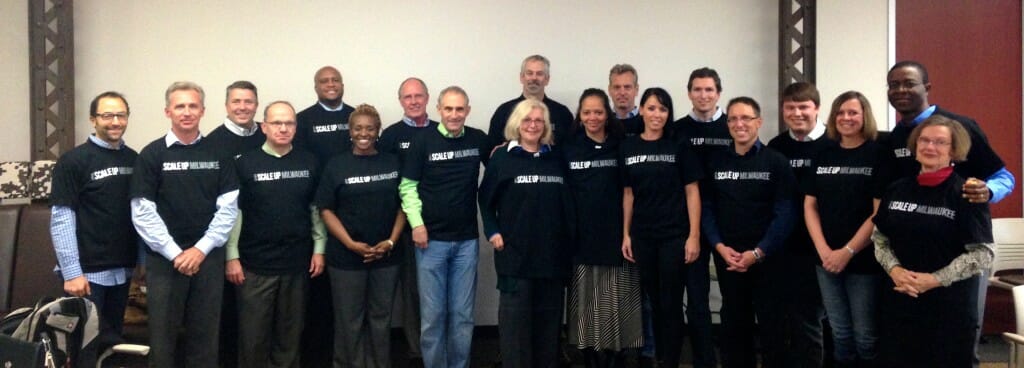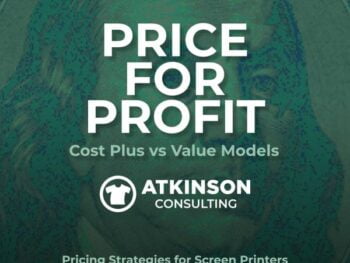Recently the owners and top executives from Visual Impressions “graduated” from the initial class of a project entitled Scale Up Milwaukee (www.scaleupmilwaukee.org). This was a very interesting class that was taught in four two day sessions by different professors from Babson College in Boston. It was organized and led by Dan Isenberg, who is a professor of entrepreneurship practice at Babson and frequently writes for Fortune magazine. The premise was simple, instead of focusing on start-up companies why not teach existing and successful thriving companies the skills and focus to grow their businesses and take them to the next level? Who wouldn’t want to participate in that?
For me, there were a number of key take-aways and enlightened moments. One of which is that if you get a bunch of top executives in a room for a few weeks you quickly learn that all of them have similar challenges. Employee problems, hiring problems, customer retention issues, what do we do next questions, how do we challenge the competition questions, etc. You are not in this alone. It was interesting to note that if you look at a company, any company, and think they are perfect and running smoothly you would be wrong. They are probably struggling with the same challenges that you are facing every day. During the class, I loved the interaction and “here’s what we did” comments that were freely given during the discussions. Lightning in a bottle…
A good chunk of the class was devoted to understanding the current state of each company, and actually focusing on where you want to go, what are the next steps, and developing a game plan for execution. This fostered a lot of internal discussions at Visual Impressions; that are still continuing actually. I think a lot of companies miss out on this growth opportunity because everyone is just focusing on getting through their day, getting through their week. Shipping the orders in front of them keeps the blinders on. Sure, there is always loose talk about next year or next quarter…but actually drawing up a game plan for execution? Usually that doesn’t happen with growing businesses. (Notice I didn’t use the phrase “small businesses” – thank you Dan!!)
I took copious notes, and I’m not going to publish them here, but I do want to share some key insights and points that were made during the lecture series as I think many companies could use some direction when thinking about growth.
As I stated, the basic idea about the class was focusing the thought process on developing a plan for growing your existing business. Every business owner is an expert on their own business and understands their market, customers, pressures, and competition. Using what you already know, think about these elements and try to envision what would make a successful strategy for the business. Choose the least risky:
- Current Product to Current Market. This method strives to build more on capturing market penetration with your current business model. How can you take what you already have and bring in more sales, and capture more of your existing market? You should consider how well your company performs currently, and what you need to do to strengthen your infrastructure to build on your success. You should also consider your competition; as they aren’t going to give up their business without a fight. Also, what are the current challenges with your current product? Can it be improved? Can you build more margin somehow?
- New Product to Current Market. Think about how introducing a new product to your current customer base might increase your sales. You already have customers and successful relationships, so what can you bring to them to bolster your sales? What is the cost for entry with a new product? How quickly can you bring it to market? What do you need to do in house to handle the new sales? What is the potential downside for adding a new product to your business?
- Current Product to New Market. Think about how you can take your current sales and find a brand new set of customers. You don’t have to invent anything new, but you do have to expend energy and maybe money finding, recruiting, closing and handling a new set of customers. What do you need to accomplish this? Would you need to hire a new sales force? Increase your current infrastructure? How do you locate the new market? What are your competitors doing?
- New Product to New Market. This is the riskiest, as you are basically launching a rocket into outer space and hoping for success with untried products and markets. To pull this off, you need to quickly grasp and comprehend factors that are going to either lead you to success or failure. You may need to make adjustments often and early. Be quick and nimble in your decision making. Here’s where the phrase “fail fast” comes into play as you don’t want to drain unnecessary capital chasing your tail. However, the reward for success could be higher and lead to even greater opportunities down the road. Are you willing to roll the dice?
So, what would you do? Pick one (or more) of these and develop your strategy. Be sure to have a crystal clear strategy surrounding the plan that details expectations, investment capital, job duties, estimations on metrics, and the most important “how will you know if you are successful” statements. Use SMART goals. (Specific, Measureable, Achievable, Realistic & Time Based)
Another great point that was shared during the discussions was how to handle objections. You want to get to “NO” as fast as you can, as there is opportunity with NO. NO is a natural part of the buying process, and presents a good opportunity to learn about your customer, your product or your company. NO says your client is listening, and outlines their concerns. If you address the concerns, you can get to something better…which is a YES. Some factors of NO:
- Misconception. Maybe the customer doesn’t understand the product. Think about how you are presenting the product, its value and how the customer will use it. Do they comprehend all the facts? Make it easy for them to understand the benefits, and take away any misinformation. How are you currently educating your customers about your product?
- Skepticism. Maybe the customer is too cautious or uncertain that your product will work the way it is supposed to. Demonstrate your product and show the benefits. This is your opportunity to show them the value and build the trust that they need to say YES. Make it obvious.
- Real Drawback. Maybe the customer is correct and your product doesn’t meet the challenge that they need it to perform. Here’s your chance to redesign it or add new features to the product to get to YES. Or, do you have something else to offer that would work? Here’s your chance to learn from your customer.
- Real Complaint. Your customer may have had past experiences that are influencing their decision. Ask more detailed questions and find out the circumstances. Build your case that your product will meet or exceed those challenges. Handle the complaint first. Empathize.
The lesson here is how do you handle your NO’s? What do your customers say? Write down their objections and find the counter-argument and develop the strategy to get to YES. This could be with more education about your company, or maybe you have to change something with your product offering. Boil it down and focus on eliminating anything that gets in the way to the YES sales statement.
Our team at Visual Impressions is working to develop our strategy for 2014 based on the lessons learned during this class. Can you guess what that strategy might be, based on the two points outlined above? By the way, our stated goal during the class is to shoot for an 18% sales growth over the next year. We used conservative numbers, and really looked at a lot of factors to determine that number. I’m very optimistic that we can hit our target. Of course, I’m not going to publish that strategy – loose lips sink ships – but over the remainder of the days left in 2013 we will be diligently refining our plan and working on executing it with gusto. This is where things get exciting!!




1 comment